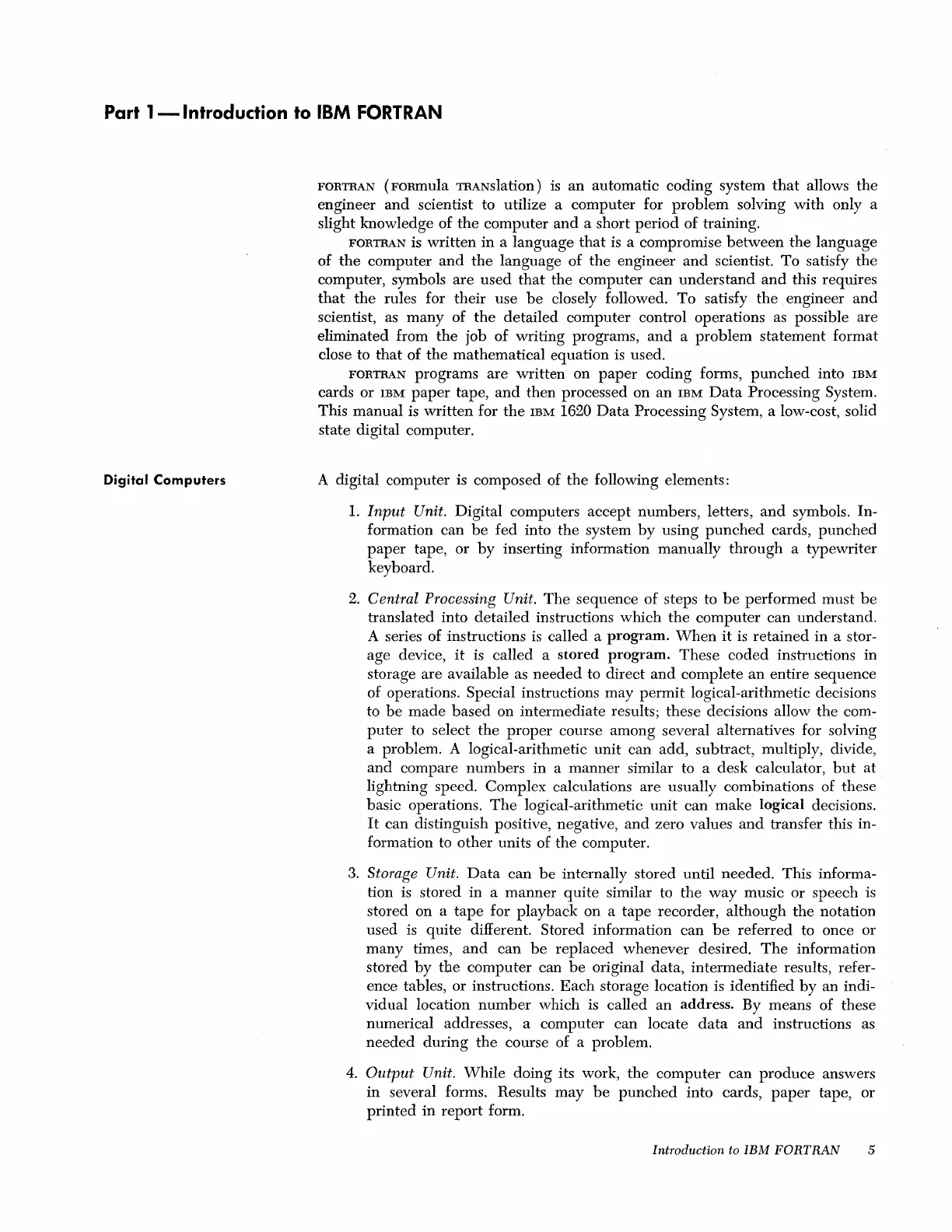Part
l-Introduction
to
IBM
FORTRAN
Digital
Computers
FORTRAN
(FORmula TRANslation)
is
an
automatic
coding
system
that
allows
the
engineer
and
scientist to utilize a
computer
for
problem
solving
with
only a
slight knowledge
of
the
computer
and
a
short
period
of
training.
FORTRAN
is
written
in
a
language
that
is a compromise
between
the
language
of
the
computer
and
the
language
of
the
engineer
and
scientist.
To
satisfy
the
computer, symbols
are
used
that
the
computer
can
understand
and
this requires
that
the
rules for
their
use
be
closely followed.
To
satisfy
the
engineer
and
scientist, as
many
of
the
detailed
computer
control operations as possible are
eliminated
from
the
job
of
writing programs,
and
a
problem
statement
format
close to
that
of
the
mathematical
equation is used.
FORTRAN
programs
are
written
on
paper
coding
forms,
punched
into
IBM
cards
or
IBM
paper
tape,
and
then
processed on
an
IBM
Data
Processing System.
This
manual
is
written
for
the
IBM
1620
Data
Processing System, a low-cost, solid
state
digital computer.
A digital
computer
is composed of
the
following elements:
1.
Input
Unit. Digital computers
accept
numbers, letters,
and
symbols. In-
formation
can
be
fed
into
the
system
by
using
punched
cards,
punched
paper
tape,
or
by
inserting information
manually
through
a
typewriter
keyboard.
2.
Central Processing Unit.
The
sequence
of
steps to
be
performed
must
be
translated into
detailed
instructions
which
the
computer
can
understand.
A series
of
instructions
is
called a
program.
When
it
is
retained
in
a stor-
age device,
it
is
called a stored
program.
These
coded
instructions in
storage
are
available as
needed
to
direct
and
complete
an
entire
sequence
of operations. Special instructions
may
permit
logical-arithmetic decisions
to
be
made
based
on
intermediate
results; these decisions allow
the
com-
puter
to select
the
proper
course
among
several alternatives for solving
a problem.
A logical-arithmetic
unit
can
add,
subtract, multiply, divide,
and
compare
numbers
in
a
manner
similar to a desk calculator,
but
at
lightning speed. Complex calculations are usually combinations
of
these
basic operations.
The
logical-arithmetic
unit
can
make
logical decisions.
It
can
distinguish positive, negative,
and
zero values
and
transfer this in-
formation to
other
units
of
the
computer.
3.
Storage Unit.
Data
can
be
internally stored
until
needed.
This informa-
tion is stored
in
a
manner
quite
similar to
the
way
music
or
speech is
stored on a
tape
for
playback
on a
tape
recorder,
although
the
notation
used
is
quite
different. Stored information
can
be
referred
to once
or
many
times,
and
can
be
replaced
whenever
desired.
The
information
stored
by
the
computer
can
be
original
data,
intermediate
results, refer-
ence
tables, or instructions.
Each
storage location is identified
by
an
indi-
vidual location
number
which is called
an
address. By means of these
numerical addresses, a
computer
can
locate
data
and
instructions as
needed
during
the
course of a problem.
4.
Output
Unit.
While
doing
its work,
the
computer
can
produce
answers
in
several forms. Results
may
be
punched
into cards,
paper
tape,
or
printed
in
report
form.
Introduction to
IBM
FORTRAN
5
